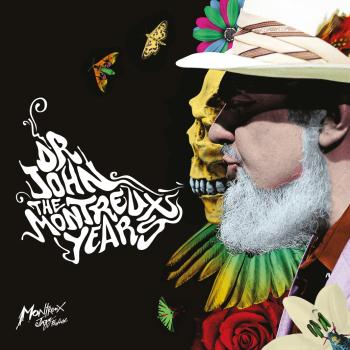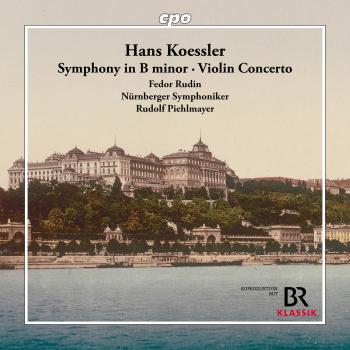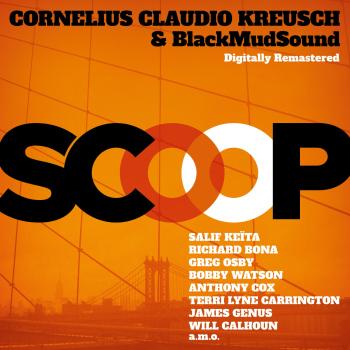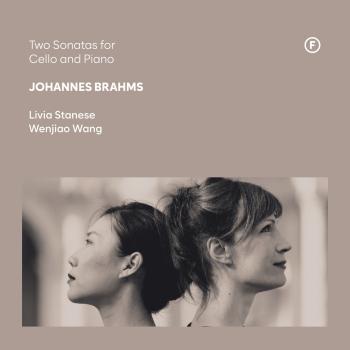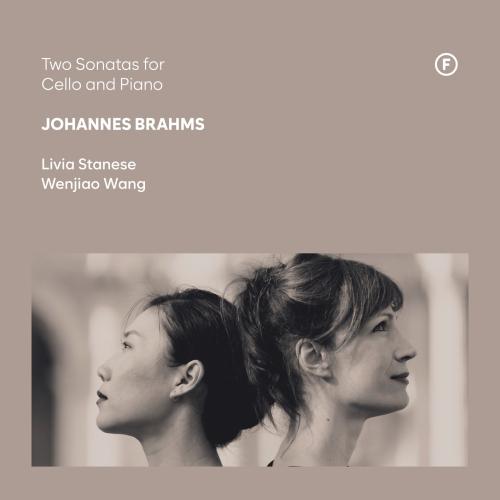
Brahms: Two Sonatas for Cello and Piano Livia Stanese & Wenjiao Wang
Album Info
Album Veröffentlichung:
2025
HRA-Veröffentlichung:
14.11.2025
Label: Fineline
Genre: Classical
Subgenre: Instrumental
Interpret: Livia Stanese & Wenjiao Wang
Komponist: Johannes Brahms (1833-1897)
Das Album enthält Albumcover Booklet (PDF)
- Johannes Brahms (1833 - 1897): Sonata for Cello and Piano No. 1 in E Minor, Op. 38:
- 1 Brahms: Sonata for Cello and Piano No. 1 in E Minor, Op. 38: I. Allegro non troppo 14:13
- 2 Brahms: Sonata for Cello and Piano No. 1 in E Minor, Op. 38: II. Allegretto quasi Menuetto 05:46
- 3 Brahms: Sonata for Cello and Piano No. 1 in E Minor, Op. 38: III. Allegro 06:36
- Sonata for Cello and Piano No. 2 in F major, Op. 99:
- 4 Brahms: Sonata for Cello and Piano No. 2 in F major, Op. 99: I. Allegro vivace 09:11
- 5 Brahms: Sonata for Cello and Piano No. 2 in F major, Op. 99: II. Adagio affettuoso 06:40
- 6 Brahms: Sonata for Cello and Piano No. 2 in F major, Op. 99: III. Allegro passionato 07:37
- 7 Brahms: Sonata for Cello and Piano No. 2 in F major, Op. 99: IV. Allegro molto 04:33
Info zu Brahms: Two Sonatas for Cello and Piano
Dieses Album vereint zwei meisterhafte Sonaten für Cello und Klavier von Johannes Brahms, die aufgrund ihrer symphonischen Breite innerhalb der Kammermusikform oft als „verhüllte Sinfonien“ bezeichnet werden. Diese Sonaten, die im Abstand von zwei Jahrzehnten entstanden sind, zeugen von Brahms’ tiefer Liebe zum Cello – einem Instrument, das er in seiner Jugend studiert hatte – und seiner intensiven Auseinandersetzung mit musikalischen Traditionen von Bach bis Beethoven. Die e-Moll-Sonate op. 38, die als Hommage an Bach konzipiert ist, entfaltet sich mit beeindruckender Intensität und verbindet romantische Ausdruckskraft mit kontrapunktischer Strenge. Der weitläufige erste Satz, das vom Tanz inspirierte Menuett und das fugierte Finale verkörpern Brahms' Fähigkeit, historische Einflüsse mit frischer emotionaler Resonanz zu verbinden.
Die F-Dur-Sonate op. 99, komponiert während eines äußerst fruchtbaren Sommers am Thunersee im Jahr 1886, offenbart einen ganz anderen Brahms: feurig, leidenschaftlich und kühn lyrisch. Das für den Cellisten Robert Hausmann geschriebene Werk beginnt mit stürmischen Tremolandi im Klavier und schwebenden Cellolinien, bevor es in einen zarten, hymnischen langsamen Satz übergeht. Ein dramatisches Scherzo voller rhythmischer Energie und ein verspieltes, aber triumphales Finale beschließen die Sonate und fangen sowohl Brahms' intellektuelle Tiefe als auch seine überschwängliche Seite ein. Zeitgenössische Kritiker mögen sich über ihre Vorzüge uneinig gewesen sein, aber die F-Dur-Sonate gilt seitdem als Eckpfeiler des Cellorepertoires.
In dieser Aufnahme bringen die Cellistin Livia Stanese und der Pianist Wenjiao Wang ihre Kunstfertigkeit und internationale Erfahrung in Brahms' Sonaten ein und beleuchten deren Ausgewogenheit zwischen struktureller Meisterschaft und herzlicher Intensität. Ihre Interpretation unterstreicht die zeitlose Anziehungskraft der Werke: Musik, die sowohl tief in den Traditionen der Vergangenheit verwurzelt ist als auch in der Gegenwart unaufhörlich lebendig bleibt.
Livia Stanese, Cello
Wenjiao Wang, Klavier
Livia Stanese
Born in 1977 into a family of musicians, Livia Stanese began studying the cello at Wenjiao Wang, born in Shenyang, China, in 1985, began playing the piano at the age of the age of seven and gave her first concert at the Villa Medici in Rome when she was eleven. She trained with Masha Janushewska, then studied at the Paris Conservatoire with Philippe Muller, graduating with top honours at the age of eighteen. She later earned a Master of Music from Rice University in Houston, studying under Paul Katz, and she was selected to play in a masterclass with legendary cellists such as Rostropovich, Yo-Yo Ma and Janos Starker. Her career was marked early on by competition successes: she won the Aspen Festival Concerto Competition (1999), took First Prize at the Potenza International Chamber Music Competitions (2001), as well as the Price Libero Lana for the best interpretation of a Brahms sonata, and was a semif inalist at the Rostropovich (2005) and Antonio Janigro (2008) competitions. A passionate chamber musician, she has shared the stage with Ivry Gitlis, Stephen Kovacevich, Jean-Frédéric Neuburger, and Geneviève Laurenceau, and has performed at major festivals such as the Mozarteum Salzburg, Dartington, Saint-Riquier, Santander, and the Flâneries Musicales de Reims.Her commitment to contemporary music is illustrated by works written for her: Trois Esquisses by Éric Tanguy (1994) and Souffle sur les cendres by Jean-Frédéric Neuburger (2010), both of which were broadcast on France Musique. In 2007, she performed the complete Bach Suites in Paris at the Festival Intrada. Since 2004, Livia has been a permanent member of the Orchestre de Chambre de Paris. She plays a 1926 Celestino Farotto cello with a by Simon F.R.
Wenjiao Wang
Born in Shenyang, China, Wenjiao Wang began playing the piano at the age of 4. Her passion for music led her to move to France at a young age, where she enrolled at the Conservatoire National Supérieur de Musique et de Danse de Paris. There, she won first prizes in piano and chamber music. She is also the recipient of several prestigious awards, including the Blüthner Classic Prize, the Ravel Academy Prize in Saint-Jean-de-Luz, and the Safran Foundation Music Prize, which was awarded to her at the Hôtel National des Invalides.
Wenjiao Wang is regularly invited to perform at numerous festivals, such as the Printemps des Arts de Monte-Carlo, where she premiered Blue Party by Christian Lauba, alongside reciter Daniel Mesguish. She has also performed in a duo with Jean-François Zygel at the 1001 Notes Festival. Her recital engagements have taken her to esteemed events like the Périgord Noir Festival, the Musique sur Ciel Festival, the Melodia di Vino Festival in Italy, and the Encuentro Internacional Arte Joven Festival in Mexico.
She has performed at prestigious venues, including Salle Gaveau, where she played a double concerto by Mozart with the Alliance Orchestra. Her chamber music concerts and recitals have also taken place at the Cité de la Musique, Salle Cortot, Musée d'Orsay, Opéra Comique in Paris, and the Shanghai Oriental Art Center in China.
Booklet für Brahms: Two Sonatas for Cello and Piano

